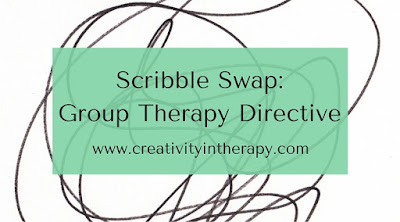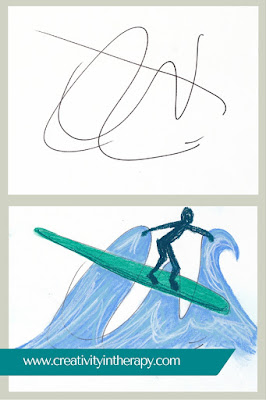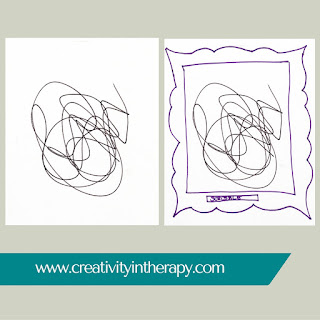If you’re looking for some ideas for group therapy activities, scribble swap drawings can be fun and stimulate good reflection and discussion from the art process.
Materials:
Paper
Pencils
Other drawing media – colored pens, markers, crayons, colored pencils, pastels, etc
Paint (maybe – I find that paint tends to lead to longer projects, so be aware of this if you want to save enough time for discussion)
Paper
Pencils
Other drawing media – colored pens, markers, crayons, colored pencils, pastels, etc
Paint (maybe – I find that paint tends to lead to longer projects, so be aware of this if you want to save enough time for discussion)
Directive:
Draw a quick scribble on your paper. Now pass your scribble to the person next to you. Take the scribble that you received and develop it into a picture.
Draw a quick scribble on your paper. Now pass your scribble to the person next to you. Take the scribble that you received and develop it into a picture.
If you’ve done scribble drawings for yourself or with therapy clients in the past, you’re aware that they can be a great directive. The scribbling back and forth across the page can be good for sensory-based regulation; the challenge of developing the scribble into an art piece can stimulate creativity and encourage listening to one’s intuition; and the focus on the art can facilitate mindfulness and relaxation (read previous post for more thoughts).
In the group discussion when I’ve done this activity, we talk both about what it was like to develop the scribble and also what it was like to work with something that you didn’t necessarily want or expect since you had to use someone else’s scribble. In both art and life, we can respond a lot of different ways to the unexpected, and a lot of these examples have come up in the art process and discussion of the groups. That’s one of the things that I love about art therapy – the way that the art process can reflect our patterns and thoughts in the rest of our life and really bring them into the therapy room. It can also be a great way to try out a new mindset when we consciously try to practice new attitudes and thoughts while working on the art.

Some of the reactions to scribble swap activity have included:
Being annoyed by getting something that they didn’t want
Embracing the challenge
Seeing it as an opportunity to be creative and draw something they never would have thought of otherwise
Being afraid to “mess up” the thing that someone else has drawn
Worrying that the art would be “wrong”
Ignoring the scribble and pretending it’s not there
Wishing that they got a different or better scribble
Feeling like the scribble they gave someone wasn’t “good enough”
Being overly ambitious and then unable to complete the art in time
It’s easy to see how each of these reactions parallels a pattern or attitude that someone might have throughout their life. As we discussed the responses and process in the art group, it was pretty easy for group members to draw the connection – how do they usually respond to the unexpected in their own life? Is it similar or different to how they responded in the art? And what would it be like to try out one of the other attitudes in their own life the next time something unexpected arises?
I’ve done this directive with both adult and teen groups. I’m not sure how it would work with younger children, but would love to hear your experience if any one tries it with kids. Also keep in mind that any directive that includes shared artwork requires a certain level of trust and connection between group members, so I wouldn’t recommend this as a directive for a newly formed group.
As usual, all art is my own as I don’t share client artwork. However, I have chosen to represent some of the “types” of pictures that I saw recently.
I’d love to hear your own experiences using scribbles in group therapy! Please share in the comments below.
Never miss a post! Be sure to sign up for the email list.
Never miss a post! Be sure to sign up for the email list.
Carolyn Mehlomakulu is a Licensed Marriage and Family Therapist and Registered Art Therapist in Austin, Texas who works with children, teens, and families. For more information about individual therapy, adolescent and child counseling, family therapy, teen group therapy, and art therapy services, please visit: www.therapywithcarolyn.com.
This blog is not intended to diagnose or treat any mental health conditions. All directives, interventions, and ideas should be used by qualified individuals within the appropriate bounds of their education, training, and scope of practice. Information presented in this blog does not replace professional training in mental health, psychotherapy, counseling, art therapy, or play therapy. Although anyone can have a healing experience with art, art therapy requires the direction of a trained art therapist.
This blog includes affiliate links(see full disclosure here). If you’d like to help support the blog without any extra cost to you, please click through on Amazon links and shop as you normally would. Your support is greatly appreciated!









Leave a Reply